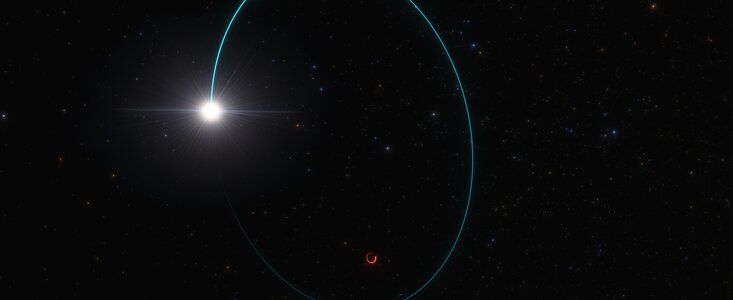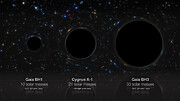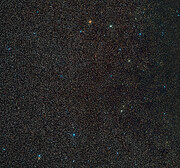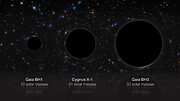Tisková zpráva
Objevena nejtěžší hvězdná černá díra v naší Galaxii
16. dubna 2024
Astronomové objevili dosud nejhmotnější hvězdnou černou díru v Mléčné dráze. Prozradila ji obíhající hvězda, která se kvůli ní při svém pohybu podivně "kymácí". Neunikla tak pozornosti mise Gaia Evropské kosmické agentury. K ověření hmotnosti černé díry byla použita data z dalekohledu Very Large Telescope Evropské jižní observatoře (ESO VLT) a dalších pozemních observatoří, podle nichž je hmotnost černé díry úctyhodných 33 hmotností Slunce.
Hvězdné černé díry vznikají zhroucením velmi hmotných hvězd. Ty, které byly dosud identifikovány v Mléčné dráze, jsou v průměru asi desetkrát těžší než Slunce. Pozorování hvězdné černé díry 33krát hmotnější než Slunce je tak opravdu výjimečné [1]. Dokonce i Cygnus X-1, druhá nejhmotnější hvězdná černá díra v Mléčné dráze, která byla dosud objevena, váží "pouhých" 21 hmotností Slunce.
Tato černá díra je také pozoruhodně blízko nás - ve vzdálenosti pouhých 2000 světelných let v souhvězdí Orla je druhou nejbližší známou černou dírou k Zemi. Díra, označovaná jako Gaia BH3 nebo zkráceně BH3, byla objevena během přípravy dat mise Gaia na jejich zveřejnění. "Nikdo nečekal, že se v naší blízkosti skrývá černá díra s tak vysokou hmotností," říká Pasquale Panuzzo, člen projektu Gaia a astronom z Pařížské observatoře (Observatoire de Paris), která je součástí francouzského Národního centra pro vědecký výzkum (CNRS). "To je objev, který se podaří jednou za život."
K potvrzení svého objevu využila skupina Gaia data z pozemních observatoří, mimo jiné z přístroje UVES (Ultraviolet and Visual Echelle Spectrograph) na ESO dalekohledu VLT, který se nachází v chilské poušti Atacama [2]. Tato data odhalila klíčové vlastnosti hvězdy doprovázející černou díru, což v kombinaci s daty z programu Gaia umožnilo astronomům přesně změřit hmotnost BH3.
Pomocí jiné detekční metody našli astronomové již dříve podobně hmotné černé díry mimo naši Galaxii. Domnívají se, že by mohly vznikat zhroucením hvězd, které se skládají z jen malého množství prvků těžších než vodík a helium. Předpokládá se, že tyto hvězdy chudé na kovy ztrácejí během svého života méně hmoty, a tudíž jim zbývá více materiálu, který může po jejich zániku vytvořit velmi hmotné černé díry. Přímý důkaz však dosud chyběl.
Dvojice hvězd mají obvykle podobné složení, což znamená, že průvodce BH3 nese důležité informace o hvězdě, která se zhroutila a vytvořila tuto výjimečnou černou díru. Data UVES ukázala, že hvězda obíhající BH3 je velmi chudá na kovy - přesně podle předpovědi.
Studie, kterou vedl Panuzzo, byla dnes publikována v časopise Astronomy & Astrophysics. "Rozhodli jsme se udělat výjimku a publikovat tuto práci založenou na předběžných datech ještě před jejich zveřejněním, protože jde o tak jedinečný objev," říká spoluautorka Elisabetta Caffau, rovněž členka projektu Gaia z pařížské observatoře (CNRS Observatoire de Paris). Uvolnění dat umožní ostatním astronomům začít studovat tuto černou díru okamžitě, aniž by museli čekat na úplná data, která budou veřejná nejdříve na konci roku 2025.
Další pozorování tohoto systému by mohla odhalit více o jeho historii i o černé díře samotné. Například přístroj GRAVITY na interferometru VLTI by mohl pomoci odhalit, zda tato černá díra přitahuje hmotu ze svého okolí, a lépe porozumět tomuto zajímavému objektu.
Poznámky
[1] Nejedná se o nejhmotnější černou díru v naší galaxii - tento titul náleží supermasivní černé díře Sagittarius A* ve středu Mléčné dráhy, která má asi čtyřmilionkrát větší hmotnost než Slunce. Gaia BH3 je však nejhmotnější známou černou dírou v Mléčné dráze, která vznikla zhroucením hvězdy.
[2] Kromě přístroje UVES na dalekohledu VLT se studie opírala o data ze spektrografu HERMES na dalekohledu Mercator Telescope, který na La Palmě (Španělsko) provozuje Univerzita v Lovani (Belgie) ve spolupráci s observatoří Ženevské univerzity (Švýcarsko), a z vysoce přesného spektrografu SOPHIE na Observatoire de Haute-Provence - OSU Institut Pythéas.
Další informace
Tento výzkum byl prezentován v článku s názvem "Discovery of a dormant 33 solar-mass black hole in pre-release Gaia astrometry", který vyjde v časopise Astronomy & Astrophysics (https://aanda.org/10.1051/0004-6361/202449763).
Autorem článku vedeného P. Panuzzem et al. je skupina Gaia zahrnující 300 vědců z celého světa, včetně Rakouska, Belgie, Česka, Finska, Francie, Německa, Itálie, Nizozemska, Polska, Portugalska, Španělska, Švédska, Švýcarska, Velké Británie, Chile a Austrálie.
Evropská jižní observatoř (ESO) umožňuje vědcům z celého světa objevovat tajemství vesmíru ve prospěch všech. Navrhujeme, stavíme a provozujeme pozemní observatoře světové úrovně, které astronomové využívají k řešení vzrušujících záhad vesmíru a šíření fascinace astronomií, a podporujeme mezinárodní spolupráci v oblasti astronomie. ESO bylo založeno jako nadnárodní organizace v roce 1962 a dnes ji podporuje 16 členských států (Belgie, Česká republika, Dánsko, Francie, Finsko, Irsko, Itálie, Německo, Nizozemsko, Polsko, Portugalsko, Rakousko, Spojené království, Španělsko, Švédsko a Švýcarsko), hostitelský stát Chile a Austrálie jako strategický partner. Sídlo ESO a její návštěvnické centrum a planetárium ESO Supernova se nachází nedaleko německého Mnichova, zatímco chilská poušť Atacama, nádherné místo s jedinečnými podmínkami pro pozorování oblohy, je domovem našich dalekohledů. ESO provozuje tři pozorovací stanoviště: La Silla, Paranal a Chajnantor. Na Paranalu provozuje Very Large Telescope a jeho Interferometr, jakož i přehlídkové dalekohledy, jako je VISTA. Na Paranalu bude ESO také hostit a provozovat soustavu Čerenkovových teleskopů (Cherenkov Telescope Array South), největší a nejcitlivější observatoř pro gama záření na světě. ESO společně s mezinárodními partnery provozuje na Chajnantoru observatoř ALMA, která pozoruje oblohu v milimetrovém a submilimetrovém pásmu. Na Cerro Armazones poblíž Paranalu budujeme "největší oko upřené k nebi" - Extremely Large Telescope. Z našich kanceláří v Santiagu v Chile podporujeme naší činnost v zemi a spolupracujeme s chilskými partnery a společností.
Odkazy
Článek ESA o tomto výzkumu
Pro novináře: přihlašte se k odběru tiskových zpráv v češtině
Pro vědce: máte pro nás námět? Popularizujte svůj výzkum
Kontakty
Pasquale Panuzzo
Observatoire de Paris - PSL/CNRS
Paris, France
Tel.: +33 1 45 07 78 42
Email: pasquale.panuzzo@observatoiredeparis.psl.eu
Elisabetta Caffau
Observatoire de Paris - PSL/CNRS
Paris, France
Tel.: +33 1 45 07 78 73
Email: elisabetta.caffau@observatoiredeparis.psl.eu
Bárbara Ferreira
ESO Media Manager
Garching bei München, Germany
Tel.: +49 89 3200 6670
Mobil: +49 151 241 664 00
Email: press@eso.org
Anežka Srbljanović (press contact Česko)
ESO Science Outreach Network
a Astronomical Institute of Czech Academy of Sciences
Tel.: +420 323 620 116
Email: eson-czech@eso.org
O zprávě
| Tiskové zpráva č.: | eso2408cs |
| Jméno: | Gaia BH3 |
| Typ: | Milky Way : Star : Evolutionary Stage : Black Hole |
| Facility: | Very Large Telescope |
| Instruments: | UVES |
| Science data: | 2024A&A...686L...2G |
Our use of Cookies
We use cookies that are essential for accessing our websites and using our services. We also use cookies to analyse, measure and improve our websites’ performance, to enable content sharing via social media and to display media content hosted on third-party platforms.
ESO Cookies Policy
The European Organisation for Astronomical Research in the Southern Hemisphere (ESO) is the pre-eminent intergovernmental science and technology organisation in astronomy. It carries out an ambitious programme focused on the design, construction and operation of powerful ground-based observing facilities for astronomy.
This Cookies Policy is intended to provide clarity by outlining the cookies used on the ESO public websites, their functions, the options you have for controlling them, and the ways you can contact us for additional details.
What are cookies?
Cookies are small pieces of data stored on your device by websites you visit. They serve various purposes, such as remembering login credentials and preferences and enhance your browsing experience.
Categories of cookies we use
Essential cookies (always active): These cookies are strictly necessary for the proper functioning of our website. Without these cookies, the website cannot operate correctly, and certain services, such as logging in or accessing secure areas, may not be available; because they are essential for the website’s operation, they cannot be disabled.
Functional Cookies: These cookies enhance your browsing experience by enabling additional features and personalization, such as remembering your preferences and settings. While not strictly necessary for the website to function, they improve usability and convenience; these cookies are only placed if you provide your consent.
Analytics cookies: These cookies collect information about how visitors interact with our website, such as which pages are visited most often and how users navigate the site. This data helps us improve website performance, optimize content, and enhance the user experience; these cookies are only placed if you provide your consent. We use the following analytics cookies.
Matomo Cookies:
This website uses Matomo (formerly Piwik), an open source software which enables the statistical analysis of website visits. Matomo uses cookies (text files) which are saved on your computer and which allow us to analyze how you use our website. The website user information generated by the cookies will only be saved on the servers of our IT Department. We use this information to analyze www.eso.org visits and to prepare reports on website activities. These data will not be disclosed to third parties.
On behalf of ESO, Matomo will use this information for the purpose of evaluating your use of the website, compiling reports on website activity and providing other services relating to website activity and internet usage.
Matomo cookies settings:
Additional Third-party cookies on ESO websites: some of our pages display content from external providers, e.g. YouTube.
Such third-party services are outside of ESO control and may, at any time, change their terms of service, use of cookies, etc.
YouTube: Some videos on the ESO website are embedded from ESO’s official YouTube channel. We have enabled YouTube’s privacy-enhanced mode, meaning that no cookies are set unless the user actively clicks on the video to play it. Additionally, in this mode, YouTube does not store any personally identifiable cookie data for embedded video playbacks. For more details, please refer to YouTube’s embedding videos information page.
Cookies can also be classified based on the following elements.
Regarding the domain, there are:
- First-party cookies, set by the website you are currently visiting. They are stored by the same domain that you are browsing and are used to enhance your experience on that site;
- Third-party cookies, set by a domain other than the one you are currently visiting.
As for their duration, cookies can be:
- Browser-session cookies, which are deleted when the user closes the browser;
- Stored cookies, which stay on the user's device for a predetermined period of time.
How to manage cookies
Cookie settings: You can modify your cookie choices for the ESO webpages at any time by clicking on the link Cookie settings at the bottom of any page.
In your browser: If you wish to delete cookies or instruct your browser to delete or block cookies by default, please visit the help pages of your browser:
Please be aware that if you delete or decline cookies, certain functionalities of our website may be not be available and your browsing experience may be affected.
You can set most browsers to prevent any cookies being placed on your device, but you may then have to manually adjust some preferences every time you visit a site/page. And some services and functionalities may not work properly at all (e.g. profile logging-in, shop check out).
Updates to the ESO Cookies Policy
The ESO Cookies Policy may be subject to future updates, which will be made available on this page.
Additional information
For any queries related to cookies, please contact: pdprATesoDOTorg.
As ESO public webpages are managed by our Department of Communication, your questions will be dealt with the support of the said Department.








